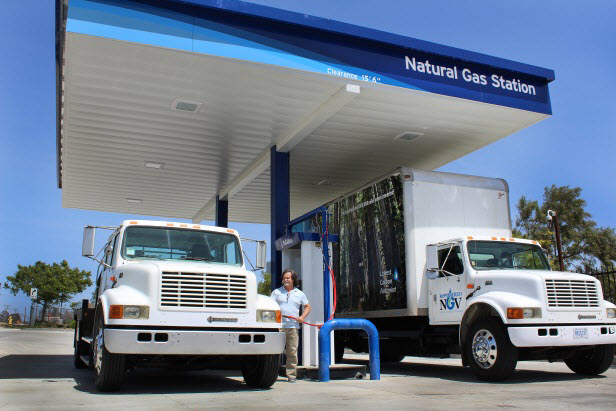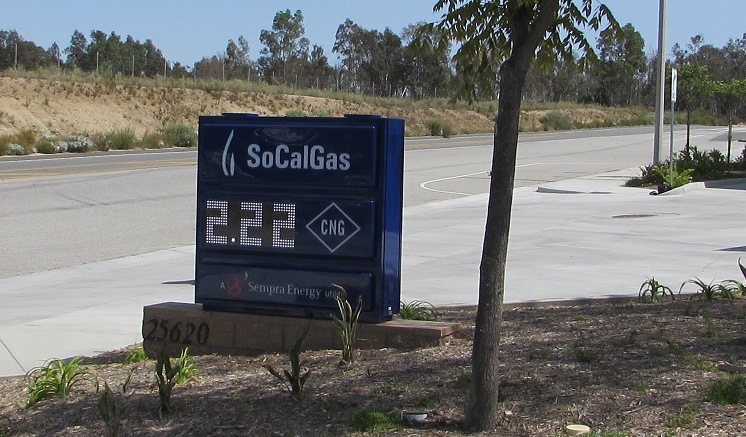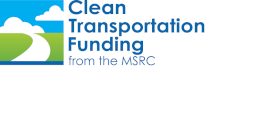 This spring, SoCalGas opened its 15th public access compressed natural gas (CNG) fueling station in Southern California, with the help of $150,000 in Clean Transportation Funding from the MSRC. The new station is located in the City of Murrieta at 41376 Guava Street, near the intersection of two freeways - I-15 and I-215. The station is open 24 hours a day, 7 days a week.
This spring, SoCalGas opened its 15th public access compressed natural gas (CNG) fueling station in Southern California, with the help of $150,000 in Clean Transportation Funding from the MSRC. The new station is located in the City of Murrieta at 41376 Guava Street, near the intersection of two freeways - I-15 and I-215. The station is open 24 hours a day, 7 days a week.
SoCalGas is committed to seeing the use of cleaner CNG expanded throughout the region. “As a utility, we are vested in this geographic area,” said Ed Harte, Clean Transportation Product Development Manager for SoCalGas. “When there are issues like air pollution, climate change and petroleum dependency facing us, SoCalGas wants to be a positive force to make an impact in a way that will help our customer base.”
 Mr. Harte points to the benefits of using natural gas as a transportation fuel to tackle some of these issues, especially when combined with the latest vehicle technology. “If you combine the new Cummins Westport near zero engines with renewable natural gas, it ups the ante and you’re able to reduce NOx 90% below what is currently mandated and reduce greenhouse gases by 80% or more. This can be done in a very affordable way with technology that exists today, so we are really excited about the prospect of that,” he explained. In fact, the MSRC currently has funding available for the new Cummins Westport ISL G Near Zero Natural Gas Engine for transit buses and refuse collection trucks (see article: The MSRC Has $10 Million in Funding Available for “Near Zero” Heavy Duty Vehicles).
Mr. Harte points to the benefits of using natural gas as a transportation fuel to tackle some of these issues, especially when combined with the latest vehicle technology. “If you combine the new Cummins Westport near zero engines with renewable natural gas, it ups the ante and you’re able to reduce NOx 90% below what is currently mandated and reduce greenhouse gases by 80% or more. This can be done in a very affordable way with technology that exists today, so we are really excited about the prospect of that,” he explained. In fact, the MSRC currently has funding available for the new Cummins Westport ISL G Near Zero Natural Gas Engine for transit buses and refuse collection trucks (see article: The MSRC Has $10 Million in Funding Available for “Near Zero” Heavy Duty Vehicles).
The convenience of the new Murrieta station is two-fold: not only is the new station located along an important transportation route in Riverside County, but it was built specifically to accommodate large trucks and buses with ease. “One of the things we wanted to do with the Murrieta station was locate it along a key corridor that could serve heavy-duty fleets, and by designing a station that can do this, smaller vehicles benefit as well. Serving heavy-duty vehicles is the hardest nut to crack. You need to make sure you are able to give customers a great experience at the pump where they can fill very quickly, using a large enough compressor and making sure the station has enough space so that the large vehicles can easily maneuver,” Mr. Harte noted.
Other station features help provide an improved experience for customers. Fuel dispensing is more like a traditional gasoline pump with nozzles that swivel easily to attach to the vehicle. The station has two dispensers with four dispenser hoses. It has drought-tolerant landscaping and a well-lit canopy that covers the fueling dispensers so drivers can fuel day or night, rain or shine. Additionally, the station’s monument sign clearly shows the price so people can see from the road how relatively inexpensive the fuel is relative to gasoline or diesel.
SoCalGas has received MSRC funding in the past to build some of its CNG stations. “We certainly appreciate all the good work the MSRC has done in terms of incentivizing the construction of the stations. There is always the chicken and the egg conundrum - do I buy the vehicle without seeing the fueling stations around, or do I build the fueling stations first even if the vehicles aren’t there,” Mr. Harte remarked. The MSRC’s funding helps address this problem.
“The MSRC incentivizing the infrastructure is really the right approach, because if you have a great value proposition for customers and the fuel is there, that’s going to provide the pull that you need. By reducing the investment that’s required for SoCalGas or anyone else who wants to build a station, that allows capital dollars to go farther. If we can defray a portion of the station cost and then use the money saved to do another project, that’s just building up the infrastructure that much faster.”
To this end, the MSRC also recently provided SoCalGas with $150,000 for the installation of a new public-access station in Pico Rivera. So, the CNG station network expansion continues!
